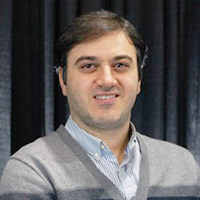 Join the Department of Chemical and Biological Engineering for a fall seminar on Wednesday, November 15 from 3:15–4:30 p.m. in Perlstein Hall Auditorium. The seminar, titled “Electrochemical Energy Conversion and Storage Systems: Promises and Challenges,” will feature Mohammad Asadi, assistant professor of chemical engineering.
Join the Department of Chemical and Biological Engineering for a fall seminar on Wednesday, November 15 from 3:15–4:30 p.m. in Perlstein Hall Auditorium. The seminar, titled “Electrochemical Energy Conversion and Storage Systems: Promises and Challenges,” will feature Mohammad Asadi, assistant professor of chemical engineering.
Electrochemistry is central to many applications such as water purification, membrane separation, sensors, energy storage and conversion systems. Among different electrochemical systems, energy storage (e.g., batteries) and conversion (hydrogen generation) systems that could harvest energy from renewable sources, e.g., solar and wind in the form of chemical bonds have received much attention due to having tremendous potential as an alternative to fossil fuels. Despite its importance, these systems have advanced more slowly over the last two decades due to the lack of suitable and affordable catalysts. To date, numerous catalysts, such as carbon derived materials, metal-carbon hybrid structures, and noble metal catalysts are extensively used for electrocatalytic reactions, despite the low reaction rates or high overpotentials. While many physical and chemical approaches have been employed to enhance the catalytic performance of these materials, it appears to be a fundamental limit, connected to the electronic structure of these catalysts.
Bhushan’s research aims to design, synthesize and characterize advanced catalysts with unique electronic properties suitable for electrocatalytic reactions. In this context, he recently found that the edge states of transition metal dichalcogenides (TMDs) in ionic liquid (IL) electrolytes offer a new paradigm for electrocatalytic reactions. Bhushan has tested the performance of this class of catalysts for the carbon dioxide (CO2) reduction reaction, oxygen reduction reaction and oxygen evolution reactions. The results include 100 times higher catalytic activity for the CO2 reduction reaction, far exceeding the performance of state-of-the-art catalysts and highly efficient bi-functional catalysts for oxygen reduction and evolution reactions compared to expensive noble metal catalysts such as platinum and gold. He has also studied the performance of molybdenum disulfide nanoflakes – a member of TMDs- for lithium-air batteries, promising alternatives to Li-ion batteries. In this talk, Bhushan will discuss these and other results including the potential of a recent finding to open a new route towards energy efficient, highly active and cost-effective electrochemical energy storage and conversion systems to replace fossil fuels.
